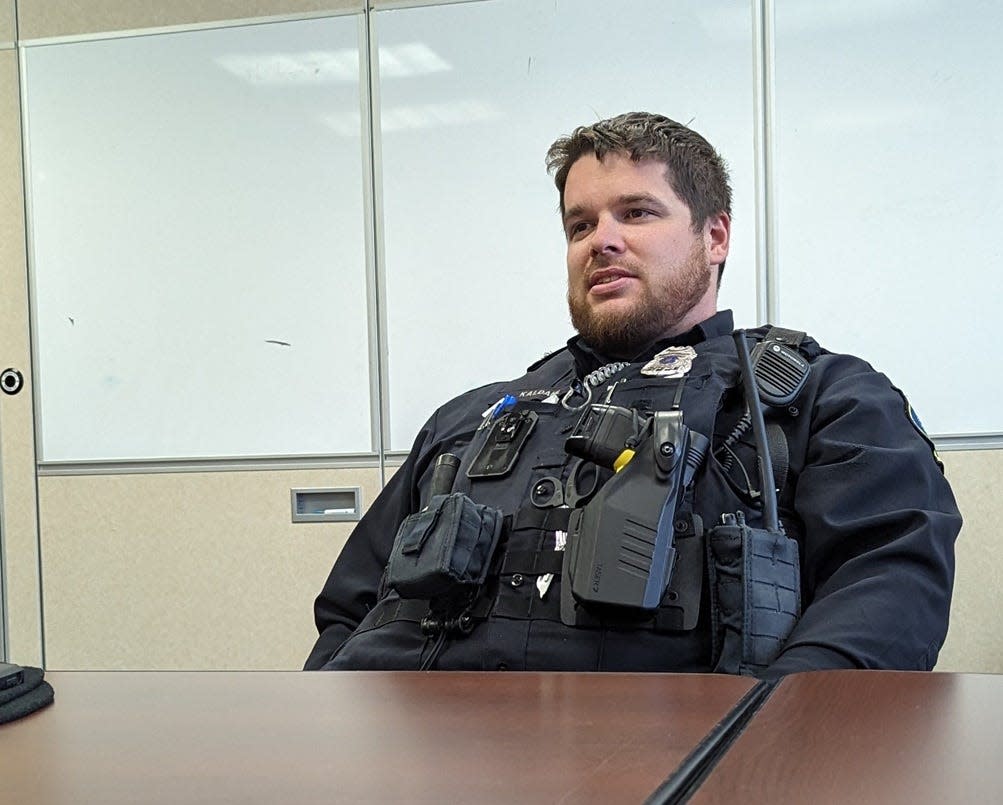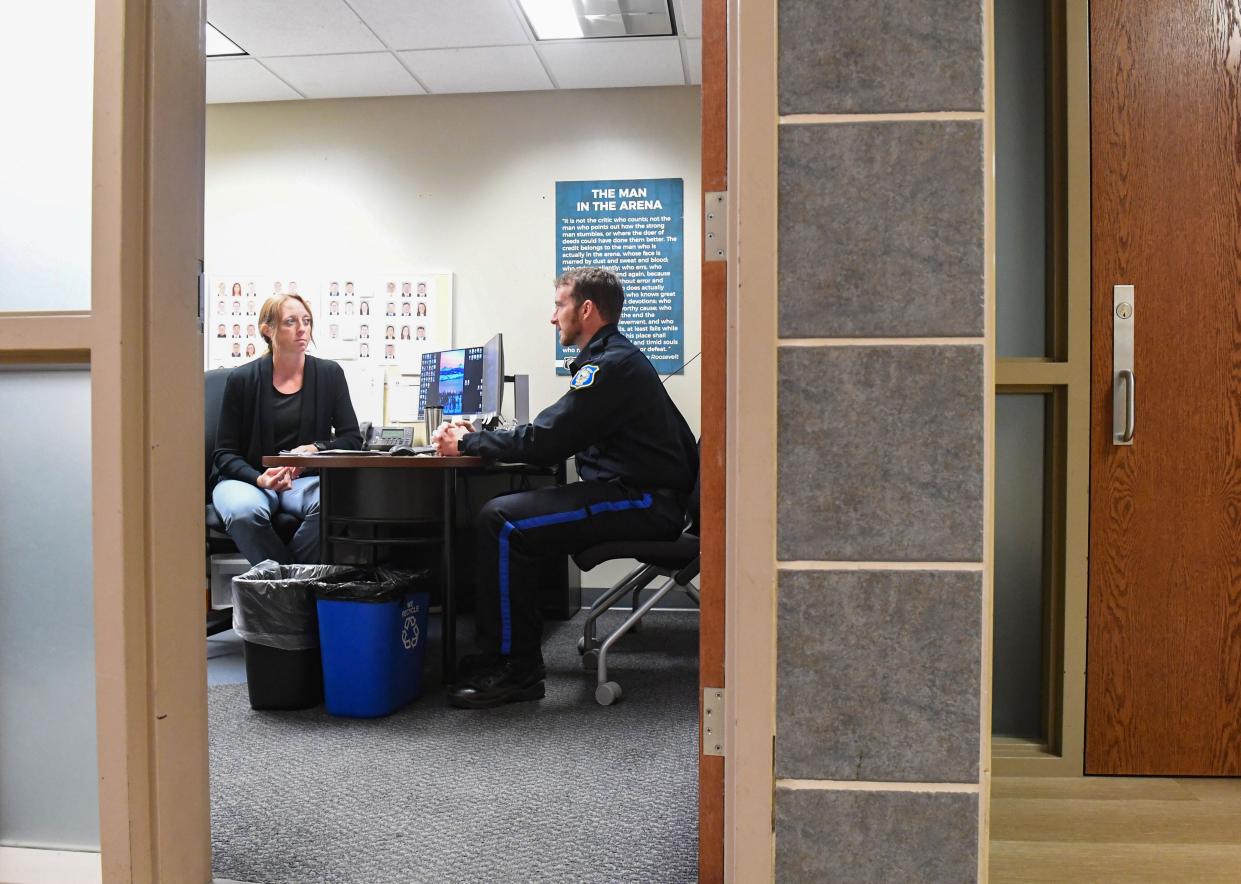Migrant officers flock to South Dakota police departments

Hours before the sun rose over Champaign, Illinois, on the morning of May 19, 2021, Champaign Police Officer Chris Oberheim and his partner were called to the scene of a domestic disturbance.
Darion Lafayette was there to meet them and exchanged fire with both officers, killing Oberheim. Lafayette was also killed.
Within a day, the slain 44-year-old officer’s squad car was parked outside the department, decorated as a memorial to the father of four and 20-year law enforcement veteran.
The memorial was vandalized in less than 24 hours.
Erik Kaldahl was about two years into his career as a Champaign police officer when his two colleagues were assaulted. By then, he said, he’d grown accustomed to “verbal abuse” from citizens. Bystanders had blocked him and other officers from accessing homicide victims, he said. He and his fellow officers had been ordered not to make arrests for low-level crimes like trespassing, he said, and his short-staffed department didn’t bother with most accident reports. There were too many violent crimes for them to attend to fender-benders.
That’s around the time Kaldahl “basically threw a dart at the map” to find somewhere – anywhere, really – that would offer him and his family more support.
“I didn’t want to raise my daughters in a place where their dad is seen as a villain,” Kaldahl said.

He eventually landed at the Sioux Falls Police Department. He was impressed by the way Sioux Falls Police Chief Jon Thum conducted himself in a press conference after an officer-involved shooting, and felt welcomed by the local officers who explained the job in Sioux Falls.
There’d be no income tax in South Dakota, he learned. He’d deal with less violent crime, and he learned he’d be free to enforce the law in a way he felt he hadn’t been in Illinois.
“This just happened to be the first one I came to and visited in person,” Kaldhal said. “The folks I spoke to here sold it pretty well.”

Police hiring trends
Kaldahl is far from alone.
The promise of a supportive community – alongside Republican-dominated politics, a lower cost of living, good schools and, for some, lax COVID vaccination policies – has drawn dozens of out-of-state officers to the Rushmore State in recent years.
A South Dakota Searchlight analysis found that at least 90 such officers have been granted reciprocity or a chance to earn it since 2018. That figure doesn’t count migrant officers who’ve been sponsored but have yet to make an official reciprocity request.
Taken together, the 90 officers represent more than 900 years of policing experience.
There are a few ways to become a certified officer in South Dakota. An agency can hire you and send you to the law enforcement academy, where certification comes with graduation. Students at technical colleges with accredited programs can apply for reciprocity, which lets them use their degree and passage of a series of post-graduate skills tests to earn the certificate without a 13-week stint at the academy.
There are two other pathways. If you’ve been out of law enforcement for two years, you can request a chance to test your way back in from the state’s Law Enforcement Officers Standards and Training Commission. Pass those tests, and the commission can take a second vote to grant you certification. If you’re certified in another state, you can start the testing and weeklong reciprocity course right away, seeing the commission just once to finalize certification.
Those last two pathways are the ones used by current or former officers to get a Rushmore State badge.
Migrant officers sponsored by agency
Sioux Falls Police Department: 19Pennington County Sheriff’s Office: 10Rapid City Police Department: 8South Dakota Highway Patrol: 8Box Elder Police Department: 3Division of Criminal Investigation: 5Lincoln County Sheriff’s Office: 3Faith Police Department: 2Game, Fish and Parks: 2Aberdeen Police Department: 2Gregory Police Department: 2Yankton Police Department: 2Pierre Police Department: 2Winner Police Department: 1South Dakota State Brand Board: 1Mitchell Police Department: 1Deadwood Police Department: 1Brandon Police Department: 1Butte County Sheriff’s Office: 1Brookings Police Department: 1Roberts County Sheriff’s Office: 1Tea Police Department: 1Brookings County Sheriff’s Office: 1Bennett County Sheriff’s Office: 1Hughes County Sheriff’s Office: 1Lake Norden Police Department: 1Fall River County Sheriff’s Office: 1Spearfish Police Department: 1Lennox Police Department: 1Freeman Police Department: 1Hamlin County Sheriff’s Office: 1Custer County Sheriff’s Office: 1Charles Mix County Sheriff’s Office: 1McCook County Sheriff’s Office: 1Clark Police Department: 1
*Does not include officers in the process of earning reciprocity
The pace of officer in-migration quickened significantly since the outrage and protests sparked by the 2020 death of George Floyd in Minneapolis.
Since that year, one in which Gov. Kristi Noem visited Los Angeles to sell the state to dissatisfied police, South Dakota law enforcement agencies have welcomed officers from San Francisco, Orange County and San Diego in California; Albuquerque, New Mexico; Austin, Texas; Madison, Wisconsin; and Denver, Colorado. Still more came from Midwestern or Southern states, including Louisiana, Missouri, Tennessee, Nebraska, North Dakota and Minnesota.
Some agencies, the Sioux Falls Police Department among them, have hired multiple out-of-state officers. The list of 90 includes 19 SFPD officers, and two others await a hearing before the state commission.
Five members of the 11-person Box Elder Police Department are South Dakota transplants, as is one of two police officers in Lake Norden, who came from California.
The chief of police in Brookings, about 40 miles southeast of Lake Norden, retired as a major from the New York State Police after 27 years and now addresses his South Dakota officers in a New England brogue.
The Highway Patrol, Division of Criminal Investigation and Department of Game, Fish and Parks have also hired out-of-state officers.
Everyone has their own story, said Sioux Falls Police Captain and recruiter Jon Lohr, but there are common themes.
COVID mandates were a big one a few years ago, he said. Income taxes and the low cost of living continue to be major selling points, especially for those whose urban homes are sure to fetch far higher prices than similar homes in South Dakota.
Ultimately, Lohr said, support from all levels of government in the state and a general pro-police sentiment are prime enticements.
“They recognize that they’re probably going to be moving to a little bit safer environment, where people probably have a little more positive feeling about their law enforcement and the officers that are doing the job,” Lohr said.
There’s another reason Sioux Falls works to be welcoming: The city and its police force are growing. Out-of-state recruits can help fill the dozen or more open positions the SFPD typically has at any given time, a number that holds steady even with the promise of a $5,000 bonus for officers who make it through their 15-month probationary period.
Reciprocity process
Officers certified in another state can’t just walk through the doors of a South Dakota department, fill out an application and be accepted into the fold of sworn South Dakota law enforcement. Reciprocity testing involves a 200-question written test to show basic competence and three proficiency exams, in firearms, use of force and emergency vehicle operations. In addition, they need to spend a week in a reciprocity class to learn the ins and outs of South Dakota law.
That process also involves a background check, according to Hank Prim, the training administrator with the South Dakota Division of Criminal Investigation.
Prim’s office uses a database called the National Decertification Index to screen reciprocity candidates for suspensions and revocations of an applicant’s law enforcement certification. That check is separate from any background investigations conducted by the hiring agency, which typically involve calls to references and previous employers and sometimes, particularly in larger departments like the SFPD, psychological evaluations and even polygraph tests.
“We’re trying to make sure that a bad officer isn’t trying to escape another state and lay their nest here,” Prim said.
None of the officers granted reciprocity or eligibility for it had their certification revoked prior to their arrival in South Dakota, according to the state commission meeting minutes. The lack of a revocation isn’t a guarantee of good behavior, however. The commission relies heavily on the background checks done by the hiring agencies, which may vary from agency to agency and may not flag all potential issues.
The commission offered a shot at reciprocity for a Pierre police officer named Jeremiah Erickson in mid-2022, but he was let go from the department before becoming certified after picking up a drunken driving charge.
The 90 out-of-state officers who’ve requested reciprocity or eligibility since 2018 only represent a fraction of total reciprocity requests. Tech school graduates from South Dakota and surrounding state represent a larger share of the total.
Even so, the impact of the pandemic and other cultural factors is reflected in overall reciprocity certifications. The commission granted 26 requests in fiscal year 2021, which began in mid-2020. It granted 61 the following fiscal year and 65 in each of the two fiscal years that followed.
On a single day in July 2022, the commission approved reciprocity or eligibility for 14 out-of-state officers.
The promise of support, Prim said, is “not a secret” outside the state’s borders.
“That secret’s come out, and that’s a good thing,” Prim said.
Welcoming community
Former Scottsdale, Arizona, officer Joseph Young joined the Box Elder force last fall. The California native and seven-year veteran of policing in the Phoenix suburb is in the process of obtaining reciprocity from South Dakota’s law enforcement commission.
Young followed his family back to South Dakota, where his grandparents grew up. He didn’t leave Scottsdale because of increased scrutiny of law enforcement, he said, but the shifting attitudes made the decision easier.
His months in Box Elder have been a culture shock for Young.
It’s not just the slower pace of life in the city of 11,000 or the reality of more frequent interactions — at grocery stores or community events, for example — with people he may have arrested or ticketed. It’s the time – time to meet people and get to know them between calls for service, and the time people make for him.
“There’s a lady I talk to almost every day who’s always out and about in her neighborhood,” said Young, who works the overnight shift. “She jogs every night. When she sees me, she starts to talk to me every time. We never had time for that in Scottsdale.”
It’s been a welcome change of pace, Young said. That slower pace has also meant a safer work environment. His father was part of the California Highway Patrol and didn’t wear a Kevlar vest for protection during the first two decades of his career, Young said.
South Dakota feels like a place where the now-standard vest feels more like a failsafe than a reminder of near-constant threat.
Young was proud to work in Scottsdale and had a larger salary there, but he doesn’t see himself leaving the community that’s embraced him.
“At the end of the day, when I go home, I feel like I’ve done my job more than I ever did in Scottsdale,” Young said.
South Dakota as retirement haven
Adam Masters was going to retire in South Dakota, with or without a job in policing.
The Texas native and his wife are “horse people” and love the Black Hills for the trails and open spaces to ride.
Even so, politics and police reforms had a hand in the timing of his retirement from Austin, Texas. Masters spent more than two decades in the city, an artsy, liberal island in Texas’ Republican political sea, and said he enjoyed nearly all of those years.
It took a while to get used to Austin when he first moved there decades ago, Masters said, but he came to love it and rarely doubted the community’s appreciation for the role of policing.
The death of George Floyd and ensuing calls to defund the police shattered that certainty, Masters said.
“We always assumed that the silent majority still supported us and backed us, and it became apparent pretty quickly that there wasn’t much of a solid majority left in Austin,” Masters said. “I don’t want to speak for anybody else, but, based off the number of resignations and retirements, I think a lot of people felt the same way I did.”
The city cut funding for its police department in 2020, and elected a district attorney who ran on a platform of prosecuting officers for misconduct. Masters and his wife decided it was time to head to the Black Hills.
He wasn’t planning to join the ranks of law enforcement in South Dakota, but he’s also young enough to keep working. In May, he took on a part-time gig as an investigator for the state Brand Board, which manages ownership inspections and investigates fraud in livestock.
Masters was surprised by the number of experienced officers he met in his reciprocity class. He walked in thinking he’d meet a lot of younger officers from the Midwest, but met seasoned officers from all over the country.
“I kind of thought I would be one of the only ones with the amount of experience that I had from as far away as I came, but that wasn’t the case at all,” Masters said.
He hasn’t regretted his decision to move to the state. Its conservative political environment suits Masters as well as the trails do – police represent “a very conservative-minded group of people,” he said – and like Young, he’s been pleasantly surprised by how welcoming the state has been.
“We knew nobody in South Dakota, but you meet your neighbors and get to know people pretty quick,” Masters said. “It feels like home now.”
Back in Sioux Falls, Kaldahl has started to feel at home, as well. He loves the school system, has sampled chislic and looks forward to going out to hunt.
That so many of his fellow officers are learning the same lessons about South Dakota at the same time has been a help.
“We have no family here. We had no friends, we have no ties,” Kaldahl said. “And I’ve run into quite a few people who are going through that exact same thing.”
This article originally appeared on Sioux Falls Argus Leader: Migrant officers flock to South Dakota police departments
